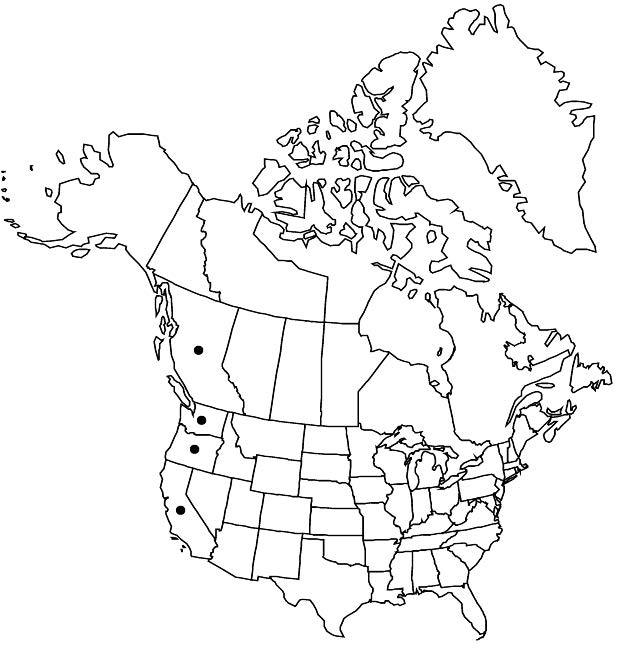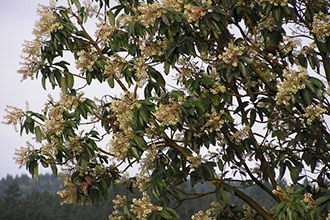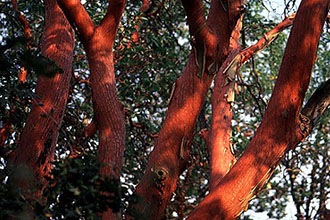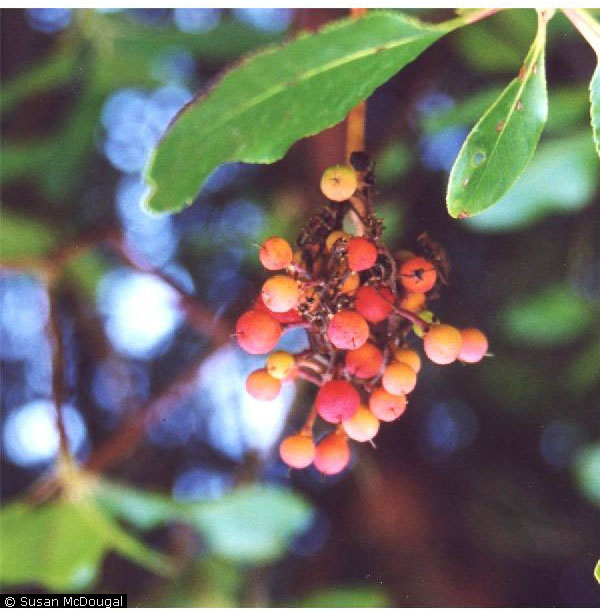USFS Plant Database
The Basics
Arbutus menziesii is a striking evergreen tree native to the North American west coast. Its range extends from coastal areas of southwestern British Columbia down through Washington, Oregon, and California. As it tends to hug the coastline, its elevation range is only 100 to 1500m above sea level. Pacific madrone grows well on fairly dry wooded slopes and canyons, especially in rocky areas. Often, Pacific madrone grows in tandem with Douglas fir and tanoak, though it also blends with redwood, lodgepole pine, Rocky Mountain juniper, western hemlock, Oregon white oak, and Pacific ponderosa pine.
Pacific madrone is an impressive tree ranging from 5 to 40m in height and diameters of 0.6-1m. Single or multiple trunks give way to heavy, crooked limbs that support a broad, spreading canopy. The leaves are evergreen and sclerophylous (glabrous, thick and waxy- an adaptation that helps prevent water loss). They are broad and elliptically shaped, ranging in size from 6.5-13cm x 3.5-8cm. The abaxial side (underside) is glaucous-green, and the adaxial side (top) is olive-green. Leaves, alternately arranged, stay on the tree for two years before turning yellow and red and are shed.
The bark of Pacific madrone is one of its most conspicuous features. Young trees vary in color from green to chartreuse to orange. As the tree ages, the bark exfoliates in large, thin scales, maturing to a smooth, deep red. Pacific madrone produces fragrant, yellowish-white to pink, urn-shaped flowers (typical of Ericaceae) held on the ends of branches.
Many birds utilize the tree for its berries and ample habitat; it provides adequate perches and nest space for a number of species. Other animals, including mule deer and large rodents like raccoons, eat the berries. Overall, Pacific madrone serves as poor fodder for strict grazing species.
A review indicates that Pacific madrone is a major component of Douglas-fir-tanoak (Pseudotsuga menziesii-Lithocarpus densiflorus)-Pacific madrone forests. These forests are characterized by an overstory of Douglas-fir with tanoak and Pacific madrone sharing the secondary canopy in varying proportions. Pacific madrone is a minor component in a variety of cover types, commonly intermingling with redwood (Sequoia sempervirens), western hemlock (Tsuga heterophylla), Oregon white oak (Quercus garryana var. garryana), and Pacific ponderosa pine (Pinus ponderosa var. ponderosa) throughout its distribution.
In British Columbia, Pacific madrone grows with lodgepole pine (Pinus contorta). The open woodlands of the San Juan Islands are characterized by Douglas-fir and Pacific madrone in a fescue (Festuca spp.) matrix. Other tree species that may be found on such sites include Rocky Mountain juniper (Juniperus scopulorum), lodgepole pine, and Oregon white oak.
The scientific name of Pacific madrone is Arbutus menziesii Pursh (Ericaceae). (Plant Database)
Identification
Shrubs or trees, 4-10(-20) m; bark dark red, smooth, until mid season when outer bark exfoliates, inner bark green, soon weathering to dark red; following exfoliation on younger wood, bark retained on oldest portions of main axis and on abaxial sides of larger lateral axes, area of retained bark gradually increasing as tree ages, becoming roughened dark gray. Leaves larger on sterile shoots with longer internodes; petiole 2-4.5 cm, base slightly decurrent, glabrous, sometimes with hairs adaxially; blade glaucous-green abaxially, olive-green adaxially (leaves of previous season turning yellow and red in June and July before they fall), elliptic, 6.5-13 × 3.5-6(-8) cm, base usually rounded, sometimes slightly cordate, rarely tapered, apex usually rounded or acute, rarely with short cusp, surfaces glabrescent (sparingly hairy on newly emerging leaves). Inflorescences (often compound), congested or not; axes hairy ± throughout, hairs not glandular. Pedicels accrescent, initially pendulous, becoming stiffly erect, 3-5(-6.2) mm, (to 6-8 mm in fruit), sometimes sparsely glandular-hairy; bract clasping base, rust-colored, scalelike, 2-3.5 mm. Flowers: calyx creamy tan at anthesis, lobes 1-2.1 mm, apex blunt; corolla 4.9-5.8 mm; anthers 1-1.2 mm, spurs usually slightly exceeding length of thecae; ovary with 2-5 ovules per locule. Berries red or orange-red, 13-20 mm diam. Seeds 2-2.5 mm. (Flora of North America)
Threats
Depending on location and forest type, Pacific madrone has evoloved under historically mixed-severity fires regimes with somewhat short fire return intervals (ranging from 5-50 years). Due to very thin bark, Pacific madrone is easily killed by fire. However, this species depends on fire to periodically eliminate shading overstory conifers. Following a fire, sprouts from the burl shoot up rapidly, due in part to the hefty amount of stored carbohydrates within the burlacs tissue. Repeated burns enhances burl development, furthering its competitive ability in early stages of succession. Pacific madrone has also adapted to establishing well in exposed mineral soils, common in post-burn areas. Fire suppression in recent times has actually hurt the species, as larger trees provide too much shade.
Pacific madrone is sensitive to a wide variety of potentially fatal pathogens. Several fungal species cause foliar diseases, heart rot, butt rot, and stem cankers. âSudden oak deathâ (Phytophthora ramorum) also affects the species, inducing foliar and branch issues, dieback, and even mortality. As human development infringes on Pacific madrone habitat, thinning stands, soil loss and compaction, and other urban impacts have increased susceptibility to disease. In Canada and Oregon, the invasive species Cytisus scoparius and Ulex europaeus compete with Pacific madrone for space, nutirients, and water. (Plant Database)
Reproduction
Pacific madrone is largely pollinated by bees. Typically, trees start producing seeds around 8 years old. Once they have reached reproductive age, flowering occurs from March to May, fruiting following suit from June to September or October. However, it is not unusual for Pacific madrone to retain its fruits well into the following January. The flowers consist of five fused petals. The fruits are produced in clumps of scarlet berries that contain a mealy pulp and an average of 20 seeds. Pacific madrone produces large amounts of seeds each year, but mortality in seedlings is high and they grow very slowly. Seeds rely on dispersal by birds, but mule deer, rodents, and gravity also aid somewhat in distribution. Disturbance favors sprouting from seed, but this form of reproduction is less common than vegetative reproduction. As such, cultivating Pacific madrone for landscaping purposes is extremely difficult.
Pacific madrone is much more effective at reproducing through vegetative sprouting. The species has a massive root system associated with ericoid mycorrhizae. In addition to providing ample anchor support in wind and drought, the root system also houses a burl at the base of the stem (trunk). Burls are large subterranean, globular, woody structures formed by the fusion of adventitious buds. In the event of disturbance that kills or damages the above-ground portion of the tree, the branchlets can sprout. Pacific madrone is considered to be an early-successional hardwood species, as it does not tolerate shade very well; its need for light increases with age. (Plant Database)
Ethnobotany
Native American tribes in the California region (the Salinan, Miwok, and Pomo) have utilized Pacific madrone in many applications. Berries were gathered to be eaten fresh or dried for later use. However, the berries have a high tannin content (an organic, bitter-tasting substance produced by plants). Often, the berries were used to make cider. They were also used as fish bait and as material for making necklaces and other decorations.
Other parts of the tree proved useful in medicinal practice. The Miwok and Cahuilla tribes chewed the leaves to alleviate cramps and stomachaches. The bark could also be processed to treat skin sores. The Pomo brewed tea from the bark to treat sores. Bark tea served as a remedy for colds and as an astringent face wash. (Plant Guide)
Distribution
Pacific madrone is native to the west coast. It occurs from southwestern British Columbia, where it is restricted to water-shedding sites on southeastern Vancouver Island, the Gulf Islands, and adjacent coastal mainland, southward through Washington, Oregon, and California in the coastal mountains and west slopes of the Sierra Nevada. The southern limit of Pacific madrone is on Mount Palomar in San Diego County, California. Pacific madrone has not been collected or reported in Mexico, although Hitchcock and others state that its distribution extends south into Baja California. (Plant Database)
 |
Citation
USDA Plant Database http://plants.usda.gov/characteristics.html USDA, NRCS. 2016. The PLANTS Database (http://plants.usda.gov, 4 February 2016). National Plant Data Team, Greensboro, NC 27401-4901 USA.
Flora of North America http://www.efloras.org/flora_page.aspx?flora_id=1 Flora of North America Editorial Committee, eds. 1993+. Flora of North America North of Mexico. 19+ vols. New York and Oxford.
Silvics of North America Burns, R.M., and B.H. Honkala. 1990. Silvics of North America (Volume 1: Conifers, Volume 2: Hardwoods). USDA Forest Service Agricultural Handbook 654.
Intermountain Herbarium http://intermountainbiota.org/portal/collections/harvestparams.php Consortium of Intermountain Herbaria. 2016. http//:intermountainbiota.org/portal/index.php. Accessed on February 04.
Burke Museum Plant Image Collection The plant image collection at the Burke Museum, University of Washington.
Jepson Manual http://ucjeps.berkeley.edu/eflora/ The Jepson Manual: Vascular Plants of California. B.G. Baldwin, D.H. Goldman, D.J. Keil, R. Patterson, T.J. Rosatti, and D.H. Wilken [editors]. 2012. 2nd edition, thoroughly revised and expanded. University of California Press, Berkeley, CA., hardcover; 1600 pages. ISBN-13: 978-0520253124.
USGS Plant Species Range Maps http://esp.cr.usgs.gov/data/little/ Critchfield, W.B., and Little, E.L., Jr., 1966, Geographic distribution of the pines of the world: U.S. Department of Agriculture Miscellaneous Publication 991, p. 1-97. Little, E.L., Jr., 1971-1978, Atlas of United States trees, volume 1,3,13,17, conifers and important hardwoods: U.S. Department of Agriculture Miscellaneous Publications.
Photos ©Susan McDougall. Trees Live Here.


